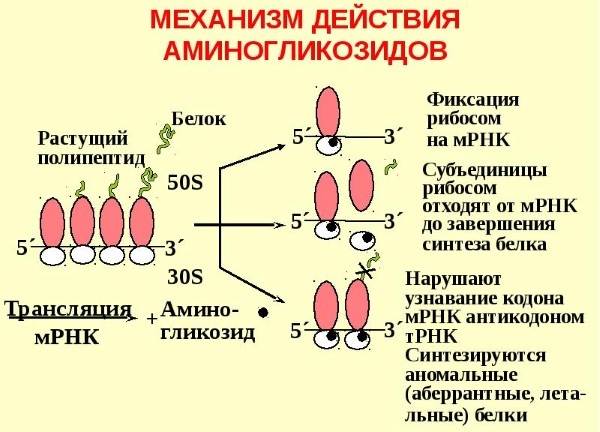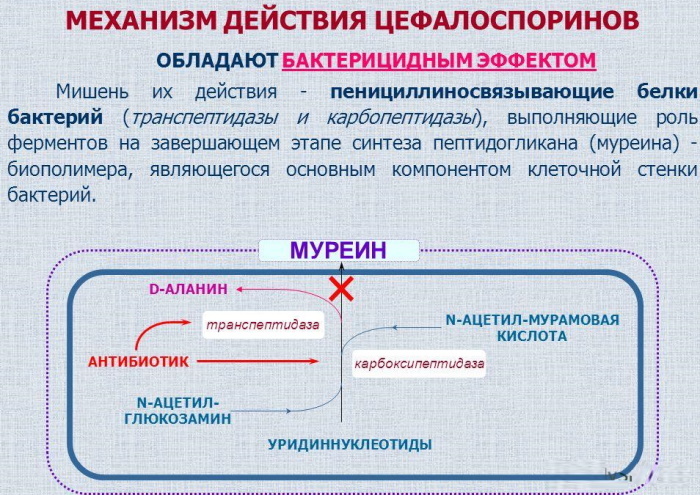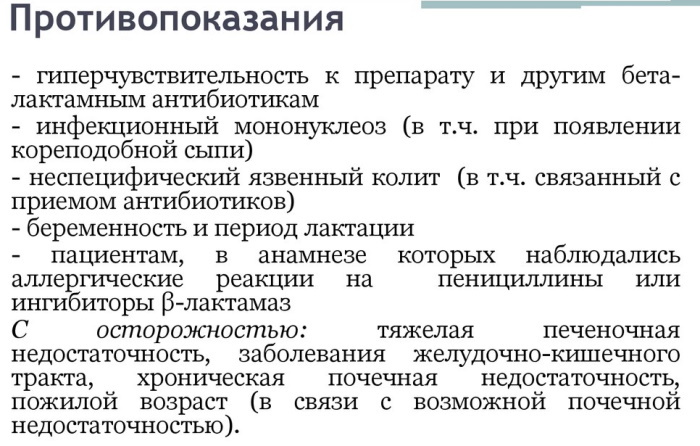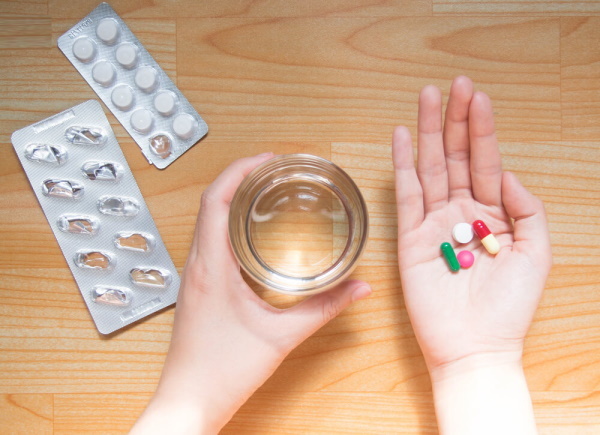Many drugs are contraindicated for breastfeeding. These include and most antibiotics. But there are situations when you can't do without them.
Record content:
- 1 Are antibiotics and lactation compatible?
- 2 Why are illegal drugs dangerous?
-
3 How to check loyalty to lactation?
- 3.1 Allowed groups
- 3.2 Prohibited groups
- 4 How to take during lactation?
- 5 Contraindications for use
- 6 What to do if the product is incompatible with feeding?
- 7 How to return to GW after a break
- 8 Antibiotic price
- 9 Video about antibiotics for HB
Are antibiotics and lactation compatible?
Antibiotics for breastfeeding should be prescribed for infections of bacterial origin. In viral diseases, their intake is useless, and in diseases caused by fungi, it can cause a deterioration in the patient's well-being.
There are antibacterial agents that can be used during lactation, and there are antimicrobial medicines that are incompatible with breastfeeding.
Why are illegal drugs dangerous?
Prohibited antibacterial medicines are excreted in breast milk and can cause adverse reactions in the baby, such as:
- allergies, which can manifest as urticaria, Quincke's edema, anaphylactic shock and cause death;
- intestinal dysbiosis, which can manifest itself as abdominal pain, indigestion, increased gas production, loss of appetite, impotence, lethargy;
- violation of the development of bone tissue and teeth;
- suppression of bone marrow function, as a result of which the amount of all blood cells decreases;
- pseudomembranous colitis, which may be accompanied by frequent stools with mucus and blood, nausea, vomiting, impotence, abdominal pain, lower blood pressure, increased heart rate, dehydration, imbalance in water-salt balance, ruptured intestines and end lethal outcome;
- hemolytic anemia, due to which the destruction of red blood cells occurs;
- staining teeth green.
How to check loyalty to lactation?
It is permissible to use antibiotics during breastfeeding only if it is provided for in the instructions for use for them.
Although often the manufacturer simply insures itself and wants to absolve itself of responsibility, if suddenly an antibacterial agent will have a negative effect on a breastfed baby, so she writes in the annotation that the medication contraindicated.
In addition, you can see information about whether the drug is compatible with breastfeeding, you can on the WHO website, in the E-lactancia directory, in various works of Russian or foreign authors, for example, in the book by Karpov and Zaitsev "The risk of using drugs during pregnancy and lactation", Thomas's reference book Hale.
What antibiotic can I breastfeed?
All antibiotics can be divided into permitted and prohibited during lactation.
Allowed groups
When treating breastfeeding patients, aminoglycosides may be prescribed (with the exception of Neomycin, which is considered the most toxic of antibiotics and there is no evidence of how safe it is for treatment during lactation).
This group includes antibiotics such as:
- Gentamicin;
- Streptomycin;
- Kanamycin;
- Amikacin;
- Tobramycin;
- Netilmicin.

They penetrate into breast milk in small concentrations. But they are poorly absorbed from the digestive tract and complications in their treatment in children, breastfed are rare, only sometimes they can disrupt the microflora their intestines.
Aminoglycosides cause the death of gram-negative and gram-positive aerobic bacteria, such as:
- colibacillus;
- proteas;
- klebsiella;
- enterobacteria;
- serration;
- acinetobacteria;
- Pseudomonas aeruginosa;
- staphylococci, except strains resistant to methicillin.
Koch's bacillus is sensitive to streptomycin and kanamycin. Amikacin acts on mycobacterium avium and other atypical mycobacteria. Streptomycin and gentamicin cause the death of enterococci. The causative agents of plague, brucellosis and tularemia are sensitive to streptomycin.
Aminoglycosides can be used for the following infections:
- sepsis of unknown origin;
- meningitis after surgery or injury;
- respiratory tract infections, including pneumonia;
- pyelonephritis, prostatitis, gonorrhea, inflammation of the bladder and urethra;
- high fever in patients with low neutrophil levels;
- infections of the digestive tract and pelvic organs;
- infectious and inflammatory disease of the inner lining of the heart;
- diabetic foot syndrome;
- purulent-necrotic process in the bone and bone marrow, which has arisen after surgery or injury;
- bacterial arthritis;
- otitis media;
- infections of the skin, including wounds seeded with pathogens;
- burn disease.
In eye drops, aminoglycosides are prescribed for conjunctivitis and keratitis of bacterial etiology.

Streptomycin is prescribed to treat plague and brucellosis. For tularemia, gentamicin and streptomycin are used. For the treatment of tuberculosis, kanamycin and streptomycin are prescribed.
In addition to aminoglycosides, antibiotics of the penicillin series can be used during lactation.
These are drugs such as:
- Benzylpenicillin potassium or sodium salt;
- Oxacillin;
- Ampicillin;
- Amoxicillin (Amosin, Flemoxin Solutab, Ekobol, Hikontsil);
- Amoxicillin with clavulanic acid (Augmentin, Amoxiclav, Flemoklav Solutab).
The following microorganisms are sensitive to them:
- streptococci;
- staphylococci;
- enterococci;
- listeria;
- corynebacteria;
- neisseria;
- the causative agent of pasteurellosis;
- Ducrey's wand;
- peptostreptococci;
- clostridia;
- spirochetes;
- colibacillus;
- shigella;
- salmonella;
- klebsiella;
- pseudomonas;
- proteas;
- citrobacters;
- Helicobacter pylori;
- gonococci.
Penicillins can be used for the following infections caused by microorganisms susceptible to them:
- ENT infections such as tonsillopharyngitis, ear and sinus infections;
- leptospirosis;
- respiratory tract infections such as inflammation and abscess of the lungs, bronchitis;
- actinomycosis;
- scarlet fever;
- blood poisoning;
- anaerobic gangrene;
- inflammation of the meninges;
- infective endocarditis;
- skin diseases of a bacterial nature, including erysipelas, impetigo, dermatoses complicated by infection;
- musculoskeletal system infections;
- syphilis, gonorrhea;
- infectious and inflammatory diseases of the genitourinary system, such as pyelonephritis, inflammation of the kidneys, bladder and urethra;
- Lyme disease
- biliary tract infections such as inflammation of the bile ducts and gallbladder;
- cervicitis;
- intestinal infections such as shigellosis, salmonellosis, paratyphoid fever, typhoid fever;
- infections of the locomotor system;
- inflammation of the peritoneum;
- pasteurellosis;
- listeriosis.

Penicillins can be used to prevent rheumatism all year round. Amoxicillin can be used for peptic ulcer disease associated with Helicobacter pylori.
Penicillins may be prescribed with caution in women who are breastfeeding. They are excreted in breast milk in small quantities, but they can cause sensitization, indigestion, candidiasis in children, and the appearance of a rash.
For the treatment of patients during lactation, cephalosporins can be used. They have a bactericidal effect.
The following infectious agents are sensitive to them:
- enterococci;
- listeria;
- streptococci;
- staphylococci;
- neisseria;
- enterobacteria, including Escherichia coli, Shigella, Salmonella;
- proteus mirabilis;
- gonococci;
- pneumococci;
- klebsiella;
- moraxella;
- haemophilus influenzae;
- meningococci;
- proteas;
- citrobacter diversion.
This group includes antibiotics such as:
- Cefazolin (Zolin);
- Cefuroxime (Zinnat, Zinacef);
- Cefotaxime (Cefabol, Oritax);
- Cefepim (Maxiceph, Maxipim);
- Ceftriaxone (Azaran, Oframax);
- Ceftazidime (Vicef);
- Cefoperazone (Sulcef);
- Cephalexin (Ecocephron);
- Cefixime;
- Cefadroxil;
- Cefaclor;
- Ceftibuten (Zedex).
 Cephalosporins can be used for diseases caused by susceptible to them pathogenic agents, including infections such as:
Cephalosporins can be used for diseases caused by susceptible to them pathogenic agents, including infections such as:
- diseases of the genitourinary system, such as pyelonephritis, cystitis, gonorrhea;
- infections of the bronchopulmonary system, including community-acquired pneumonia;
- diseases of the ENT organs, incl. streptococcal tonsillopharyngitis, acute otitis media and sinusitis;
- infectious and inflammatory diseases of the musculoskeletal system, skin and soft tissues;
- meningitis;
- infections of the abdominal and pelvic organs;
- salmonellosis;
- blood poisoning;
- diseases of a bacterial nature that have arisen in patients with neutropenia and immunodeficiency.
Small amounts of cephalosporins are excreted in breast milk. If taken during lactation, they can provoke a violation of the intestinal microflora, rash, candidiasis, sensitization in children.
Therefore, women who are breastfeeding should be taken with caution. It is impossible during lactation to use drugs containing cefixime and ceftibuten as active components.
Prohibited groups
You can not prescribe the following groups of antibiotics during lactation:
- Antibiotics of the lincosamide group. It includes lincomycin and clindamycin. These antibiotics are excreted in breast milk and can disrupt the intestinal microflora and cause sensitization in a breastfed baby. From this group, only Lincomycin-Akos ointment can be used.
- Tetracyclines. This group includes tetracycline and doxycycline. They are secreted during breastfeeding and can have a negative effect on the development of bones and teeth in a breastfed baby. From this group, only tetracycline ointment for external use can be used.
- Macrolides. This group includes medicines based on spiramycin, midecamycin, josamycin, clarithromycin, erythromycin, azithromycin, roxithromycin. Most of them are excreted in breast milk. It is not known whether azithromycin is excreted through the mammary glands, so it is also not recommended for mothers who support breastfeeding. From macrolides, Erythromycin can be used in the form of an ointment for external use.
- Quinolones. They are excreted in small amounts through the mammary glands during lactation. They can cause hemolytic anemia in breastfed babies. In experiments on animals, it was found that drugs of this group provoked arthropathy in immature individuals. But if in Russia medicines of this group are prohibited during lactation, in America, drugs based on ofloxacin are allowed for breastfeeding. Thomas Hale's handbook says that medicines based on ciprofloxacin are compatible with HB, but there have been cases when they stain the tooth enamel green or cause pseudomembranous colitis.
-
Chloramphenicol (Levomycetin). This antibiotic passes into breast milk in large doses, even if it is used in the form of eye drops and has myelotoxic effect, that is, it disrupts the function of the bone marrow, as a result of which the number of leukocytes, lymphocytes, platelets is greatly reduced, erythrocytes.
 This can lead not only to blood diseases, but also to various immunodeficiencies. Therefore, it is forbidden to lactating women.
This can lead not only to blood diseases, but also to various immunodeficiencies. Therefore, it is forbidden to lactating women.
How to take during lactation?
If antibiotic therapy is recommended for a woman during lactation, then the following recommendations should be observed:
- An antibiotic for breastfeeding should be selected by a doctor, taking into account the sensitivity of the pathogen to the antimicrobial agent, the patient's contraindications to starting antibiotic therapy.
- If 3 days have passed since the moment of taking the medication prescribed by the doctor, and there is no positive dynamics, then the antibacterial drug is changed.
- You need to take approved antibiotics while breastfeeding according to the scheme prescribed by your doctor. It is impossible to reduce the dosage of the antimicrobial agent, since in this case it will not have the desired effect on the body.
- Do not stop using antibiotics as soon as you feel better. It is imperative to undergo a course of therapy to the end. Otherwise, an exacerbation of infection and the appearance of microorganisms resistant to antibacterial agents is possible. Doctors recommend that after the signs of the disease disappear, continue antibiotic therapy for another 2 days.
- During treatment, a woman needs to monitor not only her well-being, but also the condition of the baby she is breastfeeding. If undesirable reactions appear, the course of antibiotic therapy should be interrupted immediately and seek medical help.
- Antibiotics, which are part of topical ointments, are poorly absorbed through the skin and do not have a negative effect on a breastfed baby. Therefore, even if the antibacterial agent cannot be used internally or in the form of injections, then ointments with them for external use are not contraindicated. These are drugs such as Tetracycline, Erythromycin, Lincomycin ointment for external use. They can be used in the usual way. But Tetracycline or Erythromycin eye ointment during lactation is prohibited, since their active components penetrate into the body of matter, and, therefore, can cause harm to the baby, who is on the breast feeding.
Contraindications for use
An antibiotic during breastfeeding is contraindicated in case of individual intolerance to their composition.
Aminoglycosides in injections are not allowed for the following pathologies:
- inflammation of the auditory nerve;
- severe chronic kidney dysfunction, which is accompanied by high levels of nitrogen in the blood and uremia.
Penicillins are contraindicated in case of intolerance to cephalosporins, in addition, they cannot be used for the following health problems:
- Filatov's disease;
- malignant lesion of lymphoid tissue;
- liver failure;
- a history of digestive tract pathology, especially intestinal inflammation, which is associated with antibiotic therapy.

Cephalosporins are prohibited for allergies to penicillin antibiotics.
In addition, they should be prescribed with caution to women who have the following diseases:
- liver pathology;
- kidney disease;
- history of intestinal inflammation.
What to do if the product is incompatible with feeding?
If the antibiotic is contraindicated during breastfeeding, then it should be interrupted and the baby should be transferred to the formula.
So that milk does not run out and mastitis does not start, a woman should regularly express herself, including at night. For this purpose, you can use a breast pump, when it is not there, you can express by hand.
If a woman does not want to completely interrupt breastfeeding, then it is not recommended to bottle feed the baby with a large hole, since the mixture flows out of it more easily than milk from the mother's breast and the baby may not take it again. You can use a syringe without a needle or a small spoon for feeding.
How to return to GW after a break
To restore breastfeeding, you need to follow these guidelines:
- Apply the baby to the breast every 2-3 hours. This stimulates milk production. It is imperative to apply the baby to the breast at night, since it is at this time that mammotropin, a hormone that supports lactation, is synthesized. It is also necessary to put the baby to the breast on demand, and it does not matter if it is in milk.
- Close contact between mother and baby is required throughout the day. It is advisable to carry the child in his arms, sleep with him, and also provide him with free access to the breast so that he can attach to it whenever he wants. All this stimulates the formation of milk.
- A woman should eat a balanced diet. The diet must contain meat, nuts, dairy products.
- A woman should drink up to 2 liters of liquid per day. You can take special teas for lactation, for example, Lactogon.
- During the recovery of lactation, the baby will most likely have to be fed. However, it is not recommended to use a bottle with a nipple, especially with a large opening, as it is easier to suckle than the breast. You can supplement the baby with a spoon, a syringe without a needle, and a special feeding system at the breast.
- If possible, it is advisable to abandon the pacifier, since with its help the child satisfies his sucking reflex and will take the breast less often.
- If the baby refuses to breastfeed, then a small amount of the formula can be applied to the mammary gland and offered to the baby.
- To restore lactation, a woman must get enough sleep.
- If you cannot return lactation on your own, then you can contact a breastfeeding consultation.
Antibiotic price
The cost of antibiotics depends on the specific medication and the pharmacy markup. The approximate price in rubles for some of them is as follows:
| City | Gentamicin injections | Amosin in tab. 0.5 g each № 10 | Amosin in tab. at a dose of 20 | Flemoxin Solutab 500 mg | Cephalexin in cap. 500 mg No. 16 |
| Moscow | 28 | 71 | 131 | 332 | 93 |
| St. Petersburg | 32 | 69 | 127 | 341 | 85 |
| Kazan | 39 | 72 | 129 | 358 | 89 |
| Ufa | 43 | 65 | 125 | 339 | 91 |
| Ekaterinburg | 35 | 73 | 133 | 362 | 82 |
All antibiotics are prescription drugs, so even approved breastfeeding medications should only be used on the advice of a doctor.
Video about antibiotics for HB
Komarovsky on antibiotics and breastfeeding:



